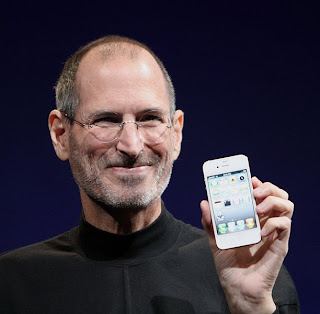
Tribute To Steve Paul Jobs – Apple Man- We Salute You A Real Visionary
Steven Paul “Steve” Jobs (February 24, 1955 – October 5, 2011) was an American computer entrepreneur and inventor. He was co-founder,[8] chairman, and chief executive officer of Apple Inc.Jobs also previously served as chief executive of Pixar Animation Studios; he became amember of the board of directors of The Walt Disney Company in 2006, following the acquisition of Pixar by Disney. He was credited in Toy Story (1995) as an executive producer.
In the late 1970s, Jobs, with Apple co-founder Steve Wozniak, Mike Markkulaand others designed, developed, and marketed one of the first commercially successful lines of personal computers, the Apple II series. In the early 1980s, Jobs was among the first to see the commercial potential of Xerox PARC’smouse-driven graphical user interface, which led to the creation of theMacintosh. After losing a power struggle with the board of directors in 1985, Jobs resigned from Apple and founded NeXT, a computer platformdevelopment company specializing in the higher-education and business markets. Apple’s subsequent 1996 buyout of NeXT brought Jobs back to the company he co-founded, and he served as its CEO from 1997 until 2011.
In 1986, he acquired the computer graphics division of Lucasfilm Ltd which was spun off as Pixar Animation Studios. He remained CEO and majority shareholder at 50.1 percent until its acquisition by The Walt Disney company in 2006. Consequently Jobs became Disney’s largest individual shareholder at 7 percent and a member of Disney’s Board of Directors. On August 24, 2011, Jobs announced his resignation from his role as Apple’s CEO.
On October 5, 2011, Apple announced that Jobs had died. He was 56 years old.
Early years

Steve Jobs at the WWDC 07
Jobs was born in San Francisco and was adopted by the Armenian family of Paul and Clara Jobsof Mountain View, California.Paul and Clara later adopted a daughter, Patti. Jobs’ biological parents – Abdul fattah John Jandali, a Syrian Muslim immigrant to the U.S from Homs, who later became a political science professor,and Joanne Schieble (later Simpson), an American graduate student who went on to become a speech language pathologist– eventually married. The marriage produced Jobs’ biological sister, novelist Mona Simpson.
Jobs attended Cupertino Junior High and Homestead High School in Cupertino, California. He frequented after-school lectures at the Hewlett-Packard Company in Palo Alto, California and was later hired there, working with Steve Wozniak as a summer employee. Following high school graduation in 1972, Jobs enrolled at Reed College in Portland, Oregon. Although he dropped out after only one semester, he continued auditing classes at Reed, while sleeping on the floor in friends’ rooms, returning Coke bottles for food money, and getting weekly free meals at the local Hare Krishnatemple. Jobs later said, “If I had never dropped in on that single calligraphy course in college, the Mac would have never had multiple typefaces or proportionally spaced fonts.”
In autumn 1974, Jobs returned to California and began attending meetings of the Homebrew Computer Club with Wozniak. He took a job as a technician at Atari, a manufacturer of popular video games, with the primary intent of saving money for a spiritual retreat to India.
Jobs then traveled to India to visit the Neem Karoli Baba at his Kainchi Ashram with a Reed College friend (and, later, the first Apple employee), Daniel Kottke, in search of spiritual enlightenment. He came back a Buddhist with his head shaved and wearing traditional Indian clothing. During this time, Jobs experimented with psychedelics, calling his LSD experiences “one of the two or three most important things done in [his] life”. He later said that people around him who did not share his counter cultural roots could not fully relate to his thinking.
Jobs returned to his previous job at Atari and was given the task of creating a circuit board for the game Breakout. According to Atari founder Nolan Bushnell, Atari had offered $100 for each chip that was eliminated in the machine. Jobs had little interest or knowledge in circuit board design and made a deal with Wozniak to split the bonus evenly between them if Wozniak could minimize the number of chips. Much to the amazement of Atari, Wozniak reduced the number of chips by 50, a design so tight that it was impossible to reproduce on an assembly line. According to Wozniak, Jobs told Wozniak that Atari had only given them $700 (instead of the actual $5,000) and that Wozniak’s share was thus $350.
Career
Founding of Apple Computer
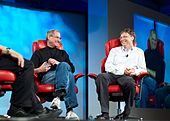
Steve Jobs and Bill Gates at the fifth D: All Things Digital conference (D5) in 2007
In 1976, Steve Jobs, Steve Wozniak and Ronald Wayne, with later funding from a then-semi-retired Intel product-marketing manager and engineer A.C. “Mike” Markkula Jr., founded Apple. Prior to co-founding Apple, Wozniak was an electronics hacker. Jobs and Wozniak had been friends for several years, having met in 1971, when their mutual friend, Bill Fernandez, introduced 21-year-old Wozniak to 16-year-old Jobs. Steve Jobs managed to interest Wozniak in assembling a computer and selling it. As Apple continued to expand, the company began looking for an experienced executive to help manage its expansion.
In 1978, Apple recruited Mike Scott from National Semiconductor to serve as CEO for what turned out to be several turbulent years. In 1983, Steve Jobs lured John Sculley away from Pepsi-Cola to serve as Apple’s CEO, asking, “Do you want to sell sugar water for the rest of your life, or do you want to come with me and change the world?” The following year, Apple aired a Super Bowl television commercial titled “1984”. At Apple’s annual shareholders meeting on January 24, 1984, an emotional Jobs introduced the Macintosh to a wildly enthusiastic audience; Andy Hertzfeld described the scene as “pandemonium”. The Macintosh became the first commercially successful small computer with a graphical user interface. The development of the Mac was started by Jef Raskin, and eventually taken over by Jobs.
While Jobs was a persuasive and charismatic director for Apple, some of his employees from that time had described him as an erratic and temperamental manager. An industry-wide sales slump towards the end of 1984 caused a deterioration in Jobs’s working relationship with Sculley, and at the end of May 1985 – following an internal power struggle and an announcement of significant layoffs because of disappointing sales at the time – Sculley relieved Jobs of his duties as head of the Macintosh division. Jobs later claimed that being fired from Apple was the best thing that could happen to him; “The heaviness of being successful was replaced by the lightness of being a beginner again, less sure about everything. It freed me to enter one of the most creative periods of my life.”
NeXT Computer
Steve Jobs on computer graphics. Interview excerpt from 1995.
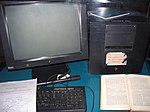
The NeXT used by Tim Berners-Lee at CERN that became the first server in theWorld Wide Web.
Jobs founded NeXT Computer in 1985 with $7 million, but a year later, Jobs ran out of money. With no product on the horizon, he appealed for venture capital. Eventually, he attracted the attention of billionaire Ross Perot who invested heavily in the company. Like the Apple Lisa, the NeXT workstation was technologically advanced, but it was largely dismissed by the educational sector it was designed for as cost-prohibitive.The NeXT workstation was known for its technical strengths, chief among them its object-oriented software development system. Jobs marketed NeXT products to the financial, scientific, and academic community, highlighting its innovative, experimental new technologies, such as the Mach kernel, the digital signal processorchip, and the built-in Ethernet port.
In 1990, the NeXTcube was described by Jobs as the first interpersonal computer which would replace the personal computing paradigm. “Interpersonal computing is going to revolutionize human communications and groupwork”, Jobs told reporters.NeXTMail, NeXT’s e-mail system, was shown as an example of the new interpersonal philosophy, which would make use of multimedia email—including voice, image, graphics, and video—as part of the network-ready NeXTcube system. NeXTMail was one of the first to support universally visible, clickable embedded graphics and audio within e-mail. Jobs declared, “While the Eighties were the age of personal computing, the Nineties will be the age of interpersonal computing.” Jobs ran NeXT with an obsession for aesthetic perfection, as evidenced by the development and attention to NeXTcube’s magnesium case.This put considerable strain on NeXT’s hardware division, and in 1993, after having sold only 50,000 machines, NeXT transitioned fully to software development with the release of NeXTSTEP/Intel. The company reported its first profit of $1.03 million in 1994. In 1996, NeXT Software, Inc. released WebObjects, a framework for web application development. After NeXT was acquired by Apple Inc. in 1997, WebObjects was used to build and run the Apple Store,MobileMe services, and the iTunes Store.
Pixar and Disney
In 1986, Jobs bought The Graphics Group (later renamed Pixar) from Lucasfilm’s computer graphics division for the price of $10 million, $5 million of which was given to the company as capital.
The new company, which was originally based at Lucasfilm’s Kerner Studios in San Rafael, California, but has since relocated toEmeryville, California, was initially intended to be a high-end graphics hardware developer. After years of unprofitability selling thePixar Image Computer, it contracted with Disney to produce a number of computer-animated feature films, which Disney would co-finance and distribute.
The first film produced by the partnership, Toy Story, brought fame and critical acclaim to the studio when it was released in 1995. Over the next 15 years, under Pixar’s creative chief John Lasseter, the company would produce the box-office hits A Bug’s Life(1998), Toy Story 2 (1999), Monsters, Inc. (2001), Finding Nemo (2003), The Incredibles (2004), Cars (2006), Ratatouille (2007),WALL-E (2008), Up (2009) and Toy Story 3 (2010). Finding Nemo, The Incredibles, Ratatouille, WALL-E, Up and Toy Story 3each received the Academy Award for Best Animated Feature, an award introduced in 2001.
In the years 2003 and 2004, as Pixar’s contract with Disney was running out, Jobs and Disney chief executive Michael Eisnertried but failed to negotiate a new partnership,and in early 2004 Jobs announced that Pixar would seek a new partner to distribute its films once its contract with Disney expired.
In October 2005, Bob Iger replaced Eisner at Disney, and Iger quickly worked to patch up relations with Jobs and Pixar. On January 24, 2006, Jobs and Iger announced that Disney had agreed to purchase Pixar in an all-stock transaction worth $7.4 billion. Once the deal closed, Jobs became The Walt Disney Company’s largest single shareholder with approximately 7% of the company’s stock. Jobs’s holdings in Disney far exceed those of Eisner, who holds 1.7%, and of Disney family member Roy E. Disney, who until his 2009 death held about 1% of the company’s stock and whose criticisms of Eisner – especially that he soured Disney’s relationship with Pixar – accelerated Eisner’s ousting. Jobs joined the company’s board of directors upon completion of the merger. Jobs also helped oversee Disney and Pixar’s combined animation businesses with a seat on a special six person steering committee.
Return to Apple
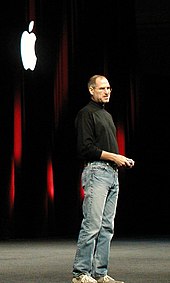
Jobs on stage at Macworld Conference & Expo, San Francisco, January 11, 2005
In 1996, Apple announced that it would buy NeXT for $429 million. The deal was finalized in late 1996, bringing Jobs back to the company he had co-founded. Jobs became de facto chief after then-CEO Gil Amelio was ousted in July. He was formally named interim chief executive in September 1997. In March 1998, to concentrate Apple’s efforts on returning to profitability, Jobs terminated a number of projects, such as Newton, Cyberdog, and OpenDoc. In the coming months, many employees developed a fear of encountering Jobs while riding in the elevator, “afraid that they might not have a job when the doors opened. The reality was that Jobs’ summary executions were rare, but a handful of victims was enough to terrorize a whole company.” Jobs also changed the licensing program for Macintosh clones, making it too costly for the manufacturers to continue making machines.
With the purchase of NeXT, much of the company’s technology found its way into Apple products, most notably NeXTSTEP, which evolved into Mac OS X. Under Jobs’s guidance the company increased sales significantly with the introduction of the iMac and other new products; since then, appealing designs and powerful branding have worked well for Apple. At the 2000 Macworld Expo, Jobs officially dropped the “interim” modifier from his title at Apple and became permanent CEO. Jobs quipped at the time that he would be using the title ‘iCEO.’
The company subsequently branched out, introducing and improving upon other digital appliances. With the introduction of the iPod portable music player, iTunes digital music software, and the iTunes Store, the company made forays into consumer electronics and music distribution. On June 29, 2007, Apple entered the cellular phone business with the introduction of the iPhone, a multi-touch display cell phone, which also included the features of an iPod and, with its own mobile browser, revolutionized the mobile browsing scene. While stimulating innovation, Jobs also reminded his employees that “real artists ship”, by which he meant that delivering working products on time is as important as innovation and attractive design.
Jobs was both admired and criticized for his consummate skill at persuasion and salesmanship, which has been dubbed the “reality distortion field” and was particularly evident during his keynote speeches (colloquially known as “Stevenotes”) atMacworld Expos and at Apple’s own Worldwide Developers Conferences.
In 2005, Jobs responded to criticism of Apple’s poor recycling programs for e-waste in the U.S. by lashing out at environmental and other advocates at Apple’s Annual Meeting in Cupertino in April. However, a few weeks later, Apple announced it would take back iPods for free at its retail stores. The Computer TakeBack Campaign responded by flying a banner from a plane over the Stanford University graduation at which Jobs was the commencement speaker. The banner read “Steve — Don’t be a mini-player recycle all e-waste”. In 2006, he further expanded Apple’s recycling programs to any U.S. customer who buys a new Mac. This program includes shipping and “environmentally friendly disposal” of their old systems.
Resignation
Apple executive Steve Jobs resigns.
In August 2011, Jobs resigned as CEO of Apple, but remained at the company as chairman of the company’s board.Hours after the announcement, Apple Inc. (AAPL) shares dropped 5% in after-hour trading. The relatively small drop, when considering the importance of Jobs to Apple, was associated with the fact that Jobs’ health had been in the news for several years, and he was on medical leave since January 2011.It was believed, according toForbes, that the impact would be felt in a negative way beyond Apple, including at The Walt Disney Company where Jobs served as director. In after-hour trading on the day of the announcement, Walt Disney Co. (DIS) shares dropped 1.5%.
Business life
Even though Jobs earned only $1 a year as CEO of Apple,[66] he held 5.426 million Apple shares, as well as 138 million shares in Disney (which he had received in exchange for Disney’s acquisition of Pixar).Forbes estimated his net wealth at $8.3 billion in 2010, making him the 42nd wealthiest American.
Stock options backdating issue
In 2001, Steve Jobs was granted stock options in the amount of 7.5 million shares of Apple with an exercise price of $18.30. It was alleged that the options had been backdated, and that the exercise price should have been $21.10. It was further alleged that Jobs had thereby incurred taxable income of $20,000,000 that he did not report, and that Apple overstated its earnings by that same amount. As a result, Jobs potentially faced a number of criminal charges and civil penalties. The case is the subject of active criminal and civil government investigations, though an independent internal Apple investigation completed on December 29, 2006, found that Jobs was unaware of these issues and that the options granted to him were returned without being exercised in 2003. On July 1, 2008, a $7 billion class action suit was filed against several members of the Apple Board of Directors for revenue lost due to the alleged securities fraud.
Management style
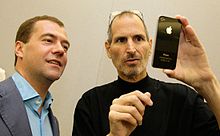
Jobs demonstrating the iPhone 4 to Russian President Dmitry Medvedev on June 23, 2010
Much was made of Jobs’ aggressive and demanding personality. Fortune wrote that he was “considered one of Silicon Valley’s leading egomaniacs”. Commentaries on his temperamental style can be found in Mike Moritz’s The Little Kingdom, one of the few authorized biographies of Jobs; The Second Coming of Steve Jobs, by Alan Deutschman; and iCon: Steve Jobs, by Jeffrey S. Young & William L. Simon. In 1993, Jobs made Fortune’s list of America’s Toughest Bosses in regard to his leadership of NeXT. Cofounder Dan’l Lewin was quoted in Fortune as saying of that period, “The highs were unbelievable … [b]ut the lows were unimaginable”, to which Jobs’s office replied that his personality had changed since then.
Jef Raskin, a former colleague, once said that Jobs “would have made an excellent king of France,” alluding to Jobs’ compelling and larger-than-life persona.
Jobs always aspired to position Apple and its products at the forefront of the information technology industry by foreseeing and setting trends, at least in innovation and style. He summed up that self-concept at the end of his keynote speech at the Macworld Conference and Expo in January 2007 by quoting ice hockey legend Wayne Gretzky:
There’s an old Wayne Gretzky quote that I love. ‘I skate to where the puck is going to be, not where it has been.’ And we’ve always tried to do that at Apple. Since the very very beginning. And we always will.
—Steve Jobs
Floyd Norman said that at Pixar, Jobs was a “mature, mellow individual” and never interfered with the creative process of the filmmakers.
In 2005, Steve Jobs banned all books published by John Wiley & Sons from Apple Stores in response to their publishing an unauthorized biography, iCon: Steve Jobs.In its 2010 annual earnings report, Wiley said it had “closed a deal … to make its titles available for the iPad.”
Inventions
Jobs is listed as either primary inventor or co-inventor in 338 US patents or patent applications related to a range of technologies from actual computer and portable devices to user interfaces (including touch-based), speakers, keyboards, power adapters, staircases, clasps, sleeves, lanyards and packages.
Philanthropy
Bloomberg accidentally published Jobs’ obituary in 2008. Arik Hesseldahl of BusinessWeek magazine opined that “Jobs isn’t widely known for his association with philanthropic causes”, compared to Bill Gates’ efforts.After resuming control of Apple in 1997, Jobs eliminated all corporate philanthropy programs.
Personal life
Jobs married Laurene Powell, on March 18, 1991. Presiding over the wedding was the Zen Buddhist monk Kobun Chino Otogawa.The couple have a son and two daughters. Jobs also has a daughter, Lisa Brennan-Jobs (born 1978), from his relationship with Bay Area painter Chrisann Brennan.She briefly raised their daughter on welfare when Jobs denied paternity by claiming he was sterile;
he later acknowledged Lisa as his daughter.
In the unauthorized biography, The Second Coming of Steve Jobs, author Alan Deutschman reports that Jobs once dated Joan Baez. Deutschman quotes Elizabeth Holmes, a friend of Jobs from his time at Reed College, as saying she “believed that Steve became the lover of Joan Baez in large measure because Baez had been the lover of Bob Dylan.” In another unauthorized biography, iCon: Steve Jobs by Jeffrey S. Young & William L. Simon, the authors suggest that Jobs might have married Baez, but her age at the time (41) meant it was unlikely the couple could have children.
Jobs was also a fan of The Beatles. He referred to them on multiple occasions at Keynotes and also was interviewed on a showing of a Paul McCartney concert.
When asked about his business model on 60 Minutes, he replied:
My model for business is The Beatles: They were four guys that kept each other’s negative tendencies in check; they balanced each other. And the total was greater than the sum of the parts. Great things in business are not done by one person, they are done by a team of people.
In 1982, Jobs bought an apartment in The San Remo, an apartment building in New York City with a politically progressive reputation, where Demi Moore, Steven Spielberg, Steve Martin, and Princess Yasmin Aga Khan, daughter of Rita Hayworth, also had apartments. With the help of I.M. Pei, Jobs spent years renovating his apartment in the top two floors of the building’s north tower, only to sell it almost two decades later to U2 singer Bono. Jobs had never moved in.
In 1984, Jobs purchased a 17,000-square-foot (1,600 m2), 14-bedroom Spanish Colonial mansion, designed by George Washington Smith, in Woodside, California (also known as Jackling House). Although it reportedly remained in an almost unfurnished state, Jobs lived in the mansion for almost ten years. According to reports, he kept an old BMW motorcycle in the living room, and let Bill Clinton use it in 1998. From the early 1990s, Jobs lived in a house in the Old Palo Alto neighborhood of Palo Alto. President Clinton dined with Jobs and 14 Silicon Valley CEOs there on August 7, 1996 on a meal catered by Greens Restaurant. Clinton returned the favor and Jobs, who was a Democratic donor, slept in the Lincoln bedroom of the White House.
Jobs allowed Jackling House to fall into a state of disrepair, planning to demolish the house and build a smaller home on the property; but he met with complaints from local preservationists over his plans. In June 2004, the Woodside Town Council gave Jobs approval to demolish the mansion, on the condition that he advertise the property for a year to see if someone would move it to another location and restore it. A number of people expressed interest, including several with experience in restoring old property, but no agreements to that effect were reached. Later that same year, a local preservationist group began seeking legal action to prevent demolition. In January 2007 Jobs was denied the right to demolish the property, by a court decision.The court decision was overturned on appeal in March 2010 and the mansion was demolished
beginning February 2011.
Jobs usually wore a black long-sleeved mock turtleneck made by St. Croix, Levi’s 501 blue jeans, and New Balance 991sneakers. He was a pescetarian, one whose diet includes fish but no other meat.
His car was a silver 2008 Mercedes SL 55 AMG, which does not display its license plates.
Jobs had a public war of words with Dell Computer CEO Michael Dell, starting when Jobs first criticized Dell for making “un-innovative beige boxes”. On October 6, 1997, in a Gartner Symposium, when Michael Dell was asked what he would do if he owned then-troubled Apple Computer, he said “I’d shut it down and give the money back to the shareholders.”
In 2006, Steve Jobs sent an email to all employees when Apple’s market capitalization rose above Dell’s. The email read::
Team, it turned out that Michael Dell wasn’t perfect at predicting the future. Based on today’s stock market close, Apple is worth more than Dell. Stocks go up and down, and things may be different tomorrow, but I thought it was worth a moment of reflection today. Steve.
Illness and death
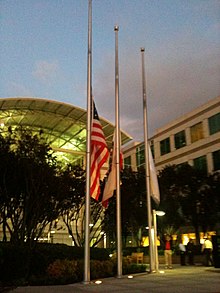
Flags flown at half-staff outside theApple Campus on the announcement of Steve Jobs’ death.
In mid-2004, Jobs announced to his employees that he had been diagnosed with a cancerous tumor in his pancreas. The prognosis for pancreatic cancer is usually very poor; Jobs, however, stated that he had a rare, far less aggressive type known asislet cell neuroendocrine tumor. After initially resisting the idea of conventional medical intervention and embarking on a special diet to thwart the disease, Jobs underwent a pancreaticoduodenectomy (or “Whipple procedure”) in July 2004 that appeared to successfully remove the tumor. Jobs apparently did not require nor receive chemotherapy or radiation therapy.During Jobs’ absence, Timothy D. Cook, head of worldwide sales and operations at Apple, ran the company.
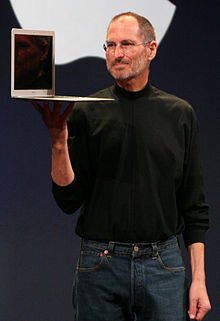
Jobs at the 2008 Macworld Conference & Expo
In early August 2006, Jobs delivered the keynote for Apple’s annual Worldwide Developers Conference. His “thin, almost gaunt” appearance and unusually “listless” delivery, together with his choice to delegate significant portions of his keynote to other presenters, inspired a flurry of media and Internet speculation about his health. In contrast, according to an Ars Technica journal report, WWDC attendees who saw Jobs in person said he “looked fine”. Following the keynote, an Apple spokesperson said that “Steve’s health is robust.”
Two years later, similar concerns followed Jobs’ 2008 WWDC keynote address.Apple officials stated Jobs was victim to a “common bug” and was taking antibiotics, while others surmised his cachectic appearance was due to the Whipple procedure.During a July conference call discussing Apple earnings, participants responded to repeated questions about Steve Jobs’ health by insisting that it was a “private matter”. Others, however, voiced the opinion that shareholders had a right to know more, given Jobs’ hands-on approach to running his company. The New York Times published an article based on an off-the-record phone conversation with Jobs, noting that “while his health issues have amounted to a good deal more than ‘a common bug,’ they weren’t life-threatening and he doesn’t have a recurrence of cancer.”
On August 28, 2008, Bloomberg mistakenly published a 2500-word obituary of Jobs in its corporate news service, containing blank spaces for his age and cause of death. (News carriers customarily stockpile up-to-date obituaries to facilitate news delivery in the event of a well-known figure’s untimely death.) Although the error was promptly rectified, many news carriers and blogs reported on it, intensifying rumors concerning Jobs’ health. Jobs responded at Apple’s September 2008 Let’s Rockkeynote by quoting Mark Twain: “Reports of my death are greatly exaggerated.”At a subsequent media event, Jobs concluded his presentation with a slide reading “110/70”, referring to his blood pressure, stating he would not address further questions about his health.
On December 16, 2008, Apple announced that marketing vice-president Phil Schillerwould deliver the company’s final keynote address at the Macworld Conference and Expo 2009, again reviving questions about Jobs’ health.In a statement given on January 5, 2009 on Apple.com, Jobs said that he had been suffering from a “hormone imbalance” for several months.On January 14, 2009, in an internal Apple memo, Jobs wrote that in the previous week he had “learned that my health-related issues are more complex than I originally thought” and announced a six-month leave of absence until the end of June 2009 to allow him to better focus on his health. Tim Cook, who had previously acted as CEO in Jobs’ 2004 absence, became acting CEO of Apple, with Jobs still involved with “major strategic decisions.”
In April 2009, Jobs underwent a liver transplant at Methodist University Hospital Transplant Institute in Memphis, Tennessee.Jobs’ prognosis was “excellent”.
On January 17, 2011, a year and a half after Jobs returned from his liver transplant, Apple announced that he had been granted a medical leave of absence. Jobs announced his leave in a letter to employees, stating his decision was made “so he could focus on his health”. As during his 2009 medical leave, Apple announced that Tim Cook would run day-to-day operations and that Jobs would continue to be involved in major strategic decisions at the company. Despite the leave, he made appearances at the iPad 2 launch event (March 2), the WWDC keynote introducing iCloud (June 6), and before the Cupertino city council (June 7).
Jobs announced his resignation from his role as Apple’s CEO on August 24, 2011. In his resignation letter, Jobs wrote that he could “no longer meet [his] duties and expectations as Apple’s CEO”.
On October 5, 2011, Jobs’ family made a statement that he “died peacefully today”.
Screenshot of Apple.com’s tribute to Steve Jobs.
Apple released a separate statement saying that Jobs had died.The statement read “We are deeply saddened to announce that Steve Jobs passed away today. Steve’s brilliance, passion and energy were the source of countless innovations that enrich and improve all of our lives. The world is immeasurably better because of Steve. His greatest love was for his wife, Laurene, and his family. Our hearts go out to them and to all who were touched by his extraordinary gifts.”
Also on October 5, 2011, Apple’s corporate website greeted visitors with a simple page showing Jobs’s name and lifespan next to his greyscale portrait. Clicking on Jobs’s image led to an obituary that read “Apple has lost a visionary and creative genius, and the world has lost an amazing human being. Those of us who have been fortunate enough to know and work with Steve have lost a dear friend and an inspiring mentor. Steve leaves behind a company that only he could have built, and his spirit will forever be the foundation of Apple.” An email address was also posted for the public to share their memories, condolences, and thoughts.
Jobs left behind his wife, Laurene, to whom he was married for 20 years; their three children; and a fourth child, Lisa Brennan-Jobs, from a previous relationship.
Source courtesy : wikepedia

